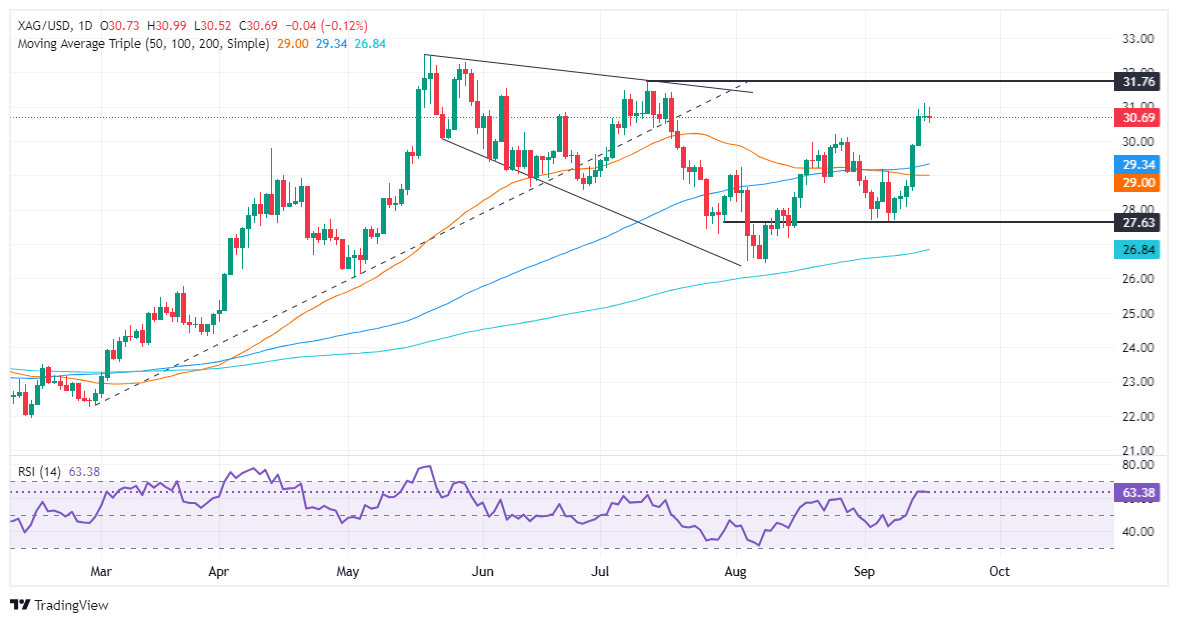Silver Price Forecast: XAG/USD is subdued around $30.60
- Silver is range-bound, amid bullish momentum, but flattening RSI signals indecision.
- A break above $31.09 could see Silver testing $31.75 and the YTD high at $32.51.
- On the downside, $30.52 is first support, followed by $29.86, with additional levels at the 100-DMA ($29.36) and 50-DMA ($28.98).
Silver price consolidates for the second straight day, prints back-to-back doji’s a sign that neither buyers nor sellers control the grey’s metal price action. At the time of writing, XAG/USD trades at $30.69, virtually unchanged, as the Wednesday Asian session commences.
XAG/USD Price Forecast: Technical outlook
Silver has been subdued during the last few days as traders brace for the Fed’s decision.
Momentum remains bullish, as portrayed by the Relative Strength Index (RSI), but its slope turned flat, hitting indecision amongst investors.
If XAG/USD clears the current week’s high of $31.09, this could underpin Siver’s to challenge the July 11 high at $31.75 ahead of the year-to-date (YTD) high of $32.51. On the other hand, if Silver drops below the September 17 daily low of $30.52, it would expose the September 13 low of $29.86, followed by the 100-day moving average (DMA) at $29.36, followed by the 50-DMA at $28.98.
XAG/USD Price Action – Daily Chart
Silver FAQs
Silver is a precious metal highly traded among investors. It has been historically used as a store of value and a medium of exchange. Although less popular than Gold, traders may turn to Silver to diversify their investment portfolio, for its intrinsic value or as a potential hedge during high-inflation periods. Investors can buy physical Silver, in coins or in bars, or trade it through vehicles such as Exchange Traded Funds, which track its price on international markets.
Silver prices can move due to a wide range of factors. Geopolitical instability or fears of a deep recession can make Silver price escalate due to its safe-haven status, although to a lesser extent than Gold's. As a yieldless asset, Silver tends to rise with lower interest rates. Its moves also depend on how the US Dollar (USD) behaves as the asset is priced in dollars (XAG/USD). A strong Dollar tends to keep the price of Silver at bay, whereas a weaker Dollar is likely to propel prices up. Other factors such as investment demand, mining supply – Silver is much more abundant than Gold – and recycling rates can also affect prices.
Silver is widely used in industry, particularly in sectors such as electronics or solar energy, as it has one of the highest electric conductivity of all metals – more than Copper and Gold. A surge in demand can increase prices, while a decline tends to lower them. Dynamics in the US, Chinese and Indian economies can also contribute to price swings: for the US and particularly China, their big industrial sectors use Silver in various processes; in India, consumers’ demand for the precious metal for jewellery also plays a key role in setting prices.
Silver prices tend to follow Gold's moves. When Gold prices rise, Silver typically follows suit, as their status as safe-haven assets is similar. The Gold/Silver ratio, which shows the number of ounces of Silver needed to equal the value of one ounce of Gold, may help to determine the relative valuation between both metals. Some investors may consider a high ratio as an indicator that Silver is undervalued, or Gold is overvalued. On the contrary, a low ratio might suggest that Gold is undervalued relative to Silver.

